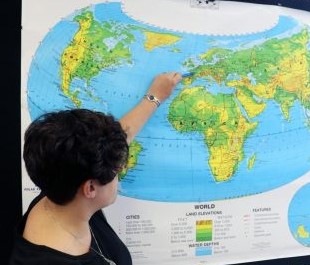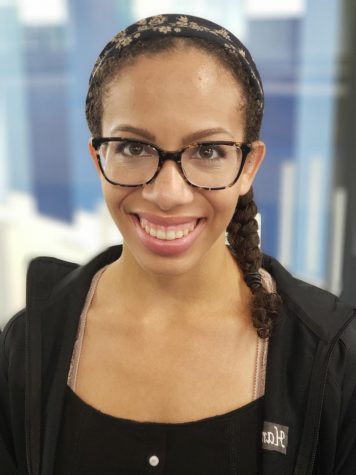Magnifying the west
The curriculum of LZHS is mainly Eurocentric

Photo by Photo by Max Feldman
Laura Kustra, world history teacher is seen pointing at Europe. The curriculum was Eurocentric but the school is moving towards a more inclusive curriculum, according to Kustra.
As America becomes more and more diverse, students are seeing a disconnect between faces in the classroom and faces in their history books.
This issue impacts students all across the country. The Common Core curriculum, which is embraced in 41 states, only requires a limited view of history and literature, according to The Century Foundation, a non-profit think tank.
The standards of the Common Core include “classic myths and stories from around the world, America’s founding documents, foundational American literature, and Shakespeare,” according to the Common Core’s official website. In response to these standards, the foundation says they are “vague, but also orient the few specific suggestions they give solely toward Western literature.”
While the Common Core may struggle with diversity, these standards are supposed to be the bare minimum for education opportunities. With that in mind, Zach Gimm, district curriculum head, says he is dedicated to keeping a balance of classic works and more diverse voices in the classroom.
“It’s hard to make the argument to remove works like The Great Gatsby just because they are Eurocentric. There’s real value there,” Gimm said. “Do you replace them because there is some other valuable voice [from a more diverse background] you want to include? With the access contemporary students have to global issues and perspectives, we are doing a disservice to them if we cannot create a deeper awareness and understanding of what those global perspectives are.”
While the curriculum is slow to change, says Gimm, the district has been working to create that deeper understanding. But the shift to a more global curriculum has both positive and negative impacts on students and teachers.
Changes in our curriculum
Before some of the changes that were made this year, the world history classes in particular were much more Eurocentric in teaching. However, not everyone agrees that the focus on European history was much of a problem.
Laura Kustra, AP World History teacher, has been teaching AP World since 2012. Since then, the curriculum has changed “drastically.”
The AP World History curriculum used to start around 8000 BCE, but the course had too much information for students to remember specifics. So the college board planned to start the class at a later date: 1450 CE.
“We all started complaining that you’re essentially saying, the history of Africa, the history of America doesn’t start until the Europeans started colonizing,” Kustra said. “And [the administration] realized that we might have had a valid argument. So they scaled it back to 1200 [CE].”
The class focuses on Asian, African, and American history. But the other history classes haven’t always been so inclusive. CP and Honors World History used to have a very Eurocentric curriculum, according to Michael Kaufman, world history teacher.
“We did have some […] other cultures and civilizations outside of the Eurocentric ideas. We talked about the ancient river valleys, and we talked about ancient China and India,” Kaufman said. “But most of our curriculum dealt with the Eurocentric idea, specifically Western Europe […]. This year, we have overhauled the curriculum to be, as the course suggests, world history.”
Kaufman says a Eurocentric curriculum can be both beneficial and detrimental to students. It’s beneficial because students already know about European time periods like the Renaissance and the Middle Ages, so they can make more connections.
But it can be detrimental because “we never talked about anybody else. So you only had this one idea. And a small view of the world,” Kaufman said.
Part of the reason the social studies department made the curriculum more inclusive was because “there’s a danger in looking at a single perspective, or one side of the story. And [we] think that happens in a lot of courses,” Steve Jeretina, social studies department head, said.
Contrary to Kaufman and Jeretina, Michael Schmitz, World History teacher, doesn’t think a Eurocentric curriculum is beneficial or detrimental. He doesn’t think the curriculum was ever Eurocentric at all.
“My understanding is when you’re teaching the Greeks and the Romans, people see that as being Eurocentric, whereas I think that’s just important history that has affected the world,” Schmitz said.
Kustra says the new, more inclusive curriculum provides students with “much more cultural sensitivity and awareness about different people in the world, what they believe in, and how they live.”
LZ tackles old curriculum with new ideas
Even as modern students connect with an increasingly global world, the country’s education system still takes a liking to Dickins and the sinking of the Spanish Armada.
Some students say they are tired of this old approach, and according to Jeretina, teachers are as well. Jeretina says there have been several efforts to create a more inclusive curriculum for future generations of students.
“We have had teachers working very diligently to revamp certain courses,” Jeretina said. “They go back to that World Studies course, which is the freshman requirement, to make sure we are being cognizant of all [different] parts of the world. We’re trying to do a better job, making sure [all the school’s curriculum] is as balanced as possible.”
Those world history courses have gone under some significant changes and revisions. The focus of the course has shifted away from a European focus to a more global perspective, Kustra says.
“Most students that took regular world history used to have a very Eurocentric history [experience], second semester was always European history. We’ve completely revamped that,” Kustra said. “Within even the non AP, we’re still incorporating African history, Indian history, and Native American history.”
However, students like Chase Larson, senior, say the courses offered in the school are too focused on Western Civilizations. Specifically in history and language courses, there need to be more options that explore global cultures, Larson says.
“If you’re looking at what history classes you can take, the big ones are Euro and APUSH, [which] are obviously Eurocentric,” Larson said. “On top of that, we only have Spanish, German, and French [language classes]. But then there are schools like Stevenson [which] offer languages like Chinese, Japanese, and Korean, which are also useful in the modern economy.”
Students can suggest new ideas like Larson’s through surveys. According to Jeretina, the social studies department is interested in developing new classes based on student opinion.
“Last year, we put out a pretty massive survey that got between 700 and 1000 students responses to potential courses that we were considering adding,” Jeretina said. “That gave us some ideas [and] gave students an opportunity to voice their [thoughts and opinions [about] what they were interested in as well.”
Curriculum’s impact on students
What one learns in school often shapes the viewpoint they have of the world, according to theatlantic.com. According to Leah Cunningham, junior, her experience in the classroom shaped how she views the world around her.
“I feel like the only view that I get is from a European perspective. And I feel with close ties with the Europeans and all those countries, I think we don’t get a very good perspective on what’s going on in other countries, because we’re so focused in on us,” Cunningham said. “Other than [a little bit from China and North Korea], I feel we kind of close out the rest of the world. And it’s hard for us even to wonder and ask questions about it. […] Then when we do ask, we don’t get a lot of background.”
Like Cunningham, growing up, Libby Reimann, AP European History teacher, felt her curriculum was primarily Eurocentric. However, as a teacher, years later, she does not see as much of a Eurocentric influence with her teaching as she did growing up.
“I took world history as a freshman in high school, that was a very long time ago and it was Eurocentric,” Reimann said. “For most of the time that I have taught here, we’ve been pretty [a pretty] Eurocentric [school].”
Over the years, there has been a massive change in curriculum, according to Reimann. But one thing remains the same, the overall impact education has on students’ perspectives.
“I think it makes kids think that some parts of the world are more important than others and that limits their future business opportunities because they’re not thinking outside of the Eurocentric box,” Reimann said. “That’s one result and I think another result is that some kids feel marginalized, because their ancestral culture isn’t recognized [in the classroom].”
By only teaching students about the history that is “important,” it decreases students’ willingness to be accepting of other cultures, according to Cunningham.
“Because we learned about the Aztecs and all them and but we don’t even go into depth about it, we just kind of graze over it. And then we talked about the colonists, and that’s all we ever talk about,” Cunningham said. “And then it’s like, but what else happened with Western Africa. We just talk about the slaves and how [they] benefited us, but we don’t talk about what happened on the other side of the story.”

As a senior, this is Sreelikhi's third year on staff and second year as the Spotlight Editor. She is a member of the Varsity Tennis team, a member of the...

As a senior, this is Max’s third year on staff and first year as magazine editor in chief for the Bear Facts program. He aspires to study environmental...

Hannah’s third year on staff is her first year as Spotlight Editor. She spends more time talking to her cats than practicing her flute as a band member....
